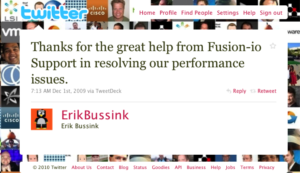I had the pleasure of catching up with Diego Pereda as part of the Social Media Fitness Study follow up interviews. Diego is the
Social Marketing Program Manager
, Corporate Marketing and Communications at Xerox Corporation and offers a number of insights, dare I say, worth copying. Thanks Diego.
DN: B2C companies seems to be ahead of B2B brands when it comes to social media. Do you think B2B marketers are skeptical about social media?
At this point in the B2C world, social media is mission critical. Consumers have demonstrated the power of social media and social media is one of the primary ways for consumer brands to interact and engage with their target audience. For B2B companies there is not always a clear connection to how their efforts in social media will translate in business results. Therefore, skepticism still exists but there are more cases from B2B companies that have embraced Social Media and are being successful with it so it is a lot easier to make the case to a Senior Executive from a B2B company that social media is here to stay, it will help their brand, or customer engagement or reduce support cost. There are many examples of B2B companies achieving just that via Social Media such as Cisco, Intel etc.
DN: How did social became a vital part of Xerox’s marketing activities?
Xerox has been developing its social marketing practice in earnest for several years, but we really stepped on the accelerator in late 2009 via a small group of what we call “social media natives” from across our business. As the practice has grown, we’ve kept track of our approaches to the work as well as some key indicators of customer engagement on the social channels. Our emerging social media gurus are engaging with prospects and customers where it makes sense for each business, and using the dominant channels – blogs, twitter, Facebook, YouTube, customer forums, etc.
DN: Can you speak to the benefits of having a cross-disciplined social media team? Was this hard to set up?
We have a cross disciplinary team that has representatives from across the company but is led by the corporate marketing organization. The team was not hard to set up as it was an evolution of the first team that started to develop social media at Xerox. A multidisciplinary team is critical as it allows you to have multiple perspectives from all the various parts of the business when developing the company SM plans and strategies. For example it is important we take into consideration when we craft our social media plans that we understand how a customer engages Xerox for support (offline and online) and understand what is the best social media platform or tool to use to help customers in seek of support.
Having a broad range of perspectives at the social media table is important so that we have access to people who are in each of the businesses and therefore our plan, strategy and tactics make sense not just from a corporate or marketing perspective, but also from a support, sales and regional perspective.
DN: Very few companies have set up a “center of excellence” for SM training. Xerox has. Can you speak to the advantages of this approach?
Our Center of Excellence is chartered with developing and executing the strategy for Social Media @ Xerox. Part of the strategy for last year was to grow the expertise of Social Media within the Xerox marketing and communications community so we developed a course for all communicators at Xerox and a series of social platform guides to teach them about using the social platforms like twitter. We also created a twice-a-month virtual get together called “Blog hour” so any of our bloggers or anyone interested in blogging can join and ask questions about anything related to blogging (technical, content, etc) or just listen to bloggers share best practices, concerns, etc And the Facebook Page administrators get together (via phone conferences) quarterly and maintain a lively discussion on our internal web collaboration platform.
The benefits we have derived from the Center of Excellence efforts and activities are that we have empowered more of our marketing and communications community to get involved in social media and to do it with the benefit of training and best practices at their disposal. We have witnessed a growth on all of our major platforms (Twitter, Facebook, Blogs) and we attribute a great deal of this growth and development of pods of social media practioners outside of the Center of Excellence to these efforts.
DN: Why do think this is so challenging for B2B marketers to create engaging content?
I think companies in the B2B space sometimes lose sight of the people making the decisions within the businesses that they are trying to reach via social media. At the end of the day whether B2C or B2B you should be producing content that will resonate with the people that that will be making some decision: purchase, recommendation, RFP decision, etc Our CMO often refers to it as B2P, Business-to-people.
DN: Only 1 in 3 B2B companies have started/completed an audit of their social media account. What’s up with that?
I think that this is actually a good indication that B2B companies are seeing a need to audit. This is something that we are planning to do in 2012.






